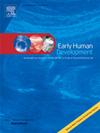向早产儿伸出援助之手:“粘手套”对探索行为和后期发展影响的随机对照试验
IF 2
3区 医学
Q2 OBSTETRICS & GYNECOLOGY
引用次数: 0
摘要
对普通人群中3个月大的婴儿进行的研究表明,玩“粘手套”对他们的探索行为有好处。粘连指手套是尼龙搭扣覆盖的连指手套,与尼龙搭扣覆盖的玩具一起使用,使学龄前的婴儿能够通过拍打玩具来抓取和移动玩具。我们的随机对照试验研究了在父母的监督下,在家庭环境中玩粘连指手套是否同样可以改善早产儿的探索行为和后期发展。参与者(N = 62, 25-33孕周)在3个月大时被招募,并被随机分配到干预组或积极对照组。在三周的时间里,干预组每天最多5-10分钟,定期使用粘性连指手套,而对照组则看着他们的看护者移动玩具。在干预前后立即评估了面向对象的探索性行为,护理人员完成了关于婴儿发育的问卷,直到15个月的矫正年龄。结果显示,干预组在口部及口部附近手工摸索玩具的效果显著优于对照组,F = 9.24, p = 0.004, ηp2 = 0.13, F = 8.07, p = 0.006, ηp2 = 0.12。然而,根据父母报告问卷,两组在接下来的一年里表现出了相同的发展。0.05. 虽然粘连指手套干预对早产儿的探索行为有直接的好处,但在得出关于对他们发展的长期影响的结论之前,还需要更多的研究。本文章由计算机程序翻译,如有差异,请以英文原文为准。
Lending a helping hand to preterm infants: Randomized controlled trial of the impact of ‘sticky mittens’ on exploratory behavior and later development
Research with 3-month-old infants from the general population has shown benefits to their exploratory behavior from play involving ‘sticky mittens’. Sticky mittens are Velcro-covered mittens that are used with Velcro-covered toys to enable pre-reaching infants to grab and move toys simply by swatting at them. Our randomized controlled trial examined whether sticky mittens play, supervised by parents in the home environment, could similarly improve the exploratory behavior and later development of preterm infants. Participants (N = 62, 25–33 weeks of gestation) were recruited at 3 months of age corrected for prematurity and assigned randomly to either an intervention or active control group. For up to 5–10 min per day for three weeks, the intervention group used sticky mittens regularly while the control group instead watched their caregiver move the toys. Object-oriented exploratory behavior was evaluated immediately before and after the intervention, and caregivers completed questionnaires about their infant's development until 15 months' corrected age. Results showed that the intervention group made significantly greater gains than the control group in mouthing, F = 9.24, p = .004, ηp2 = 0.13, and bimanual exploration of the toys at or near the mouth, F = 8.07, p = .006, ηp2 = 0.12. However, the groups showed equivalent development over the next year as gauged by parent-report questionnaires p's > 0.05. While the sticky mittens intervention has immediate benefits for preterm infants' exploratory behavior, more research is needed before conclusions can be drawn regarding the longer-term impact on their development.
求助全文
通过发布文献求助,成功后即可免费获取论文全文。
去求助
来源期刊

Early human development
医学-妇产科学
CiteScore
4.40
自引率
4.00%
发文量
100
审稿时长
46 days
期刊介绍:
Established as an authoritative, highly cited voice on early human development, Early Human Development provides a unique opportunity for researchers and clinicians to bridge the communication gap between disciplines. Creating a forum for the productive exchange of ideas concerning early human growth and development, the journal publishes original research and clinical papers with particular emphasis on the continuum between fetal life and the perinatal period; aspects of postnatal growth influenced by early events; and the safeguarding of the quality of human survival.
The first comprehensive and interdisciplinary journal in this area of growing importance, Early Human Development offers pertinent contributions to the following subject areas:
Fetology; perinatology; pediatrics; growth and development; obstetrics; reproduction and fertility; epidemiology; behavioural sciences; nutrition and metabolism; teratology; neurology; brain biology; developmental psychology and screening.
 求助内容:
求助内容: 应助结果提醒方式:
应助结果提醒方式:


